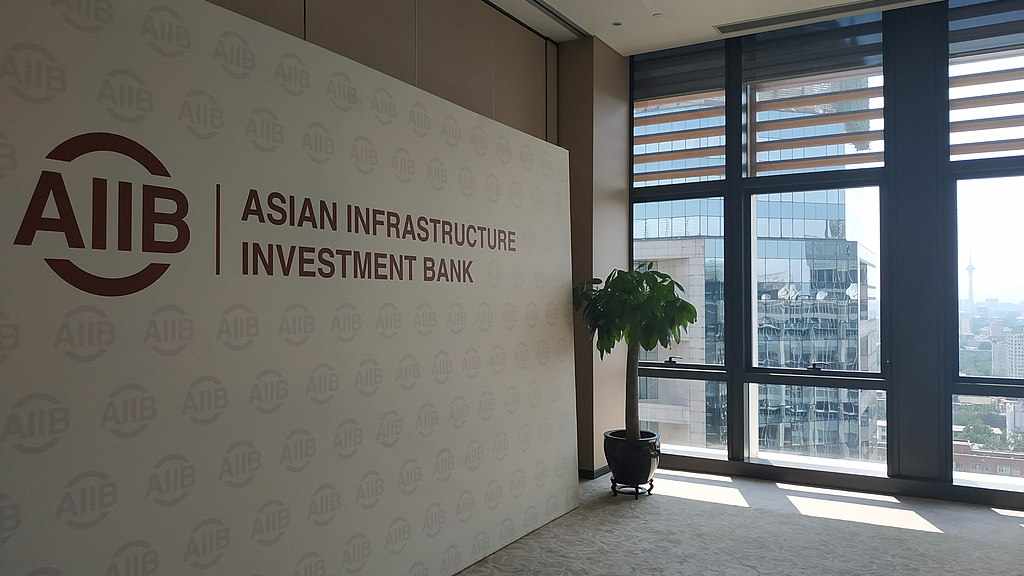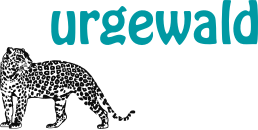This article first appeared in the Rosa Luxemburg Foundation's dossier "The New Silk Roads" (link below).
China's Belt and Road Initiative requires billions of dollars of investment. Numerous actors are involved in financing the individual projects, one of which is the Asian Infrastructure Investment Bank. This bank, which is largely controlled by China, is still a relatively small player, but its influence is growing steadily.
When the Asian Infrastructure Investment Bank (AIIB) was established in October 2013, many asked why. Was there a need for another Asia-focused international financial institution (IFI) alongside the globally active World Bank and the regionally based Asian Development Bank (ADB)? Yes, China and other emerging economies believed. They had long demanded that their voting weight in the World Bank be increased to reflect their increased economic strength. But the U.S. Congress blocked this, while the Europeans supported the voting changes. The AIIB is thus China's attempt to break U.S. dominance in the IFIs.
But the AIIB is also part of China's new foreign policy, which created a new framework for an aggressive investment policy. Already after joining the World Trade Organization (WTO) in 2001, diplomatic attention turned to bilateral treaties as well as free trade agreements, especially with neighboring Asian countries. Step by step, the "dream of a resurgent China" - the slogan when Xi Jinping came to power in 2013 - was prepared. True, the AIIB is a multilateral bank, as its Chinese president Jin Liqun repeatedly emphasizes. But at the same time, together with the Silk Road Fund and China's major state banks, it serves to finance costly energy and transportation infrastructure projects under the Belt and Road Initiative (BRI). However, Chinese state-owned banks have a much larger overall share in financing BRI projects.
The establishment of the bank in 2015 succeeded in splitting the unity of the developed countries of the Global North. The U.S. made great efforts to dissuade its allies from joining the AIIB. However, they only succeeded with Japan and (currently still) Canada. When the UK announced it would join, the dam was broken and the other European countries joined the queue of those willing to join. There was a suspicion that Downing Street was concerned with anchoring foreign exchange trading with the Chinese currency in the financial center of London. At the same time, there were fears that the AIIB would also be an attack on the supremacy of the U.S. dollar. However, China denied this. However, the IMF subsequently included the yuan in the basket of currencies used to calculate its special drawing rights, thus increasing the importance of the Chinese currency in the international financial system.
With the accession of European countries, the AIIB increased its initial capital from $50 billion to $100 billion. One-fifth was paid in directly, while the remaining 80 percent is in the form of guarantees. In the case of Germany, this amounts to $900 million as a deposit and $3.6 billion in guarantees. This enabled the AIIB to obtain the highest rating of AAA from the rating agencies, which is also held by the World Bank, for example. The better the rating, the cheaper it is for the bank to refinance through debt securities (bonds). In mid-2020, the AIIB placed its first bond on the financial market, interestingly enough in Chinese currency. These bonds are a safe choice for investors of all kinds because of their high rating.
Since development banks each have limits on the amount they can lend to individual borrowing countries, a new bank is another source of funding. Co-financing can thus circumvent these thresholds. Country X, which can only get a loan of a maximum amount Y from the World Bank, is thus enabled to borrow additional money from the AIIB for a project. The problem is, of course, that the debt sustainability of the borrowing countries can be not only exhausted but exceeded. Economic shocks such as the Corona pandemic can lead to a new over-indebtedness crisis.
A "Chinese bank" with a strong president
In its organizational structure, the AIIB is modeled on the structure of all other development banks. China, as the largest shareholder, has the (unwritten) right to nominate the president of the AIIB, as does the United States with the World Bank. He is elected by the Board of Directors, whose twelve members represent the member countries. This body advises on the bank's policies, strategies and allocations. Unlike the World Bank, however, the members of the Board of Directors (Excutive Directors) are not based in Beijing, but meet regularly in person or by videoconference for their deliberations. Through this structure, the AIIB aims to realize part of its business principle of "lean, clean and green". However, this precludes the informal interaction and information flow between board members and management that is part of daily operations at the World Bank or ADB, for example.
Also of concern is the very strong position of the AIIB's president. Under the accountability framework, President Jin Liqun can independently approve projects up to $200 million in the public sector, up to $100 million in the private sector, and $35 million in equity investments without a prior decision by the Board of Directors. Starting in mid-2021, the first two amounts will increase even further to $300 million and $150 million, respectively. To be sure, any of the 12 members of the board can request that individual decisions be pulled into the body. But this is complicated by the problematic information rules. In general, the goal is for the board to take care of the "big picture," while leaving the day-to-day business to the president and his management. This does not ensure sufficient control by the board of directors.
Environmental and social standards yes, duty to inform no
"Lean, clean and green" are also referred to by the AIIB as guidelines for the Environmental and Social Framework (ESF) as well as the Disclosure Policy and Accountability Rules. Even before the start of operations in January 2016, the ESF was adopted, while the other rules were put into effect some time after. By involving former World Bank employees* in the drafting of the ESF, the AIIB wanted to prove that the rules stood up to comparison with international standards. To someone not familiar with the details, it also looks like this. All the key words and descriptions of objectives that are important to stakeholders are named. But as always, the devil is in the details.
The ESF places almost all responsibility on borrowers. They are supposed to do due diligence on the environmental and social impacts of the project, inform and consult with stakeholders, and report on the progress of the project and any problems that arise. Project promoters should even evaluate the possibility of not implementing their own project. The AIIB is then responsible for the credit decision based on the documents submitted. This should ensure lean administration.
In general, it is very important that local communities that are (negatively) affected by projects are fully informed before projects are approved and implemented. In this way, problems can be identified at an early stage and, if possible, avoided. However, it is precisely in this area that the ESF's greatest weakness lies, rendering the good formulations in the descriptions of objectives worthless.
In the ESF, there are no binding deadlines for when information must be published. It only says that stakeholders should be consulted. However, exactly when and how this is to take place is left completely open. There is even the possibility for the Bank to approve a project without even completing an environmental and social impact assessment. How then the Board of Directors is supposed to take a decision in case of doubt, even though basic information is not available, is so far a mystery.
When criticism was raised that there were no binding information deadlines prior to project approval, the AIIB referred to the Disclosure Policy. This, in turn, deals with all other documents of the bank. When it comes to projects, it refers to the ESF. A classic circular argument that leaves information seekers in a Kafkaesque position. In the upcoming revision of the ESF in 2020/21, the European AIIB member countries want this gap to be closed with clear rules. However, the first drafts of the new version are still without binding time-critical specifications.
Criticism of the complaints mechanism
Because the AIIB, like all other development banks, has immunity as an international institution, it cannot be sued if individuals or communities affected by projects feel their rights have been violated. IFIs have established independent accountability mechanisms for such cases. At the AIIB, however, the unit that deals with complaints is only one part of a unit that is also responsible for anti-corruption and evaluation. As such, however, this unit is too close to/in management to be truly independent. In addition, the hurdles in the regulations are so high that it is almost impossible for those affected to come forward with their concerns. In the case of projects financed jointly by AIIB and other banks, it refers to the other financial institution both in terms of the environmental and social standards to be applied and in the case of complaints.
Another point of concern is the application of environmental and social standards of state or private borrowers* instead of the own ESF. The rationale for this is that it allows clients to deal with familiar rules and builds their capacity where there are still gaps or weaknesses. However, again, there are no clear rules on how to ensure and publicize that the standards of the borrowers are indeed equivalent.
At first glance, the AIIB has an organizational structure and regulatory system that is equivalent to the standards of the other IFIs. However, a closer look reveals serious weaknesses and gaps. The AIIB's system is lean, but the "clean" and "green" categories are questionable. Urgewald published a study on this in 2019, criticizing the AIIB's organizational structure and standards in detail.
Germany, China and the Bank
When the ratification of Germany's accession to the AIIB was imminent, the Bundestag set clear guidelines regarding Germany's accession and formulated: "Against this background, all parliamentary groups called on the German government to demand high environmental, social, human rights and governance standards in the further negotiations on the AIIB's standards, such as at least those of the World Bank, including, for example, the exclusion of investments in nuclear and coal-fired power plants; to advocate for the establishment of an efficient monitoring instrument. Advocate, in further negotiations on AIIB standards, for the standards in place at other international financial institutions, particularly the World Bank, with respect to AIIB accountability and transparency; Advocate, in further negotiations, for an independent grievance mechanism . ..""
The record of the effort, however, looks bleak. There is no coal exclusion, environmental and social standards, and transparency and grievance mechanism fall far short of World Bank standards. There are also fears that investment in nuclear power will be promoted under the Climate Change Investment Framework launched in September 2020.
Of course, this meager record will not lead to an exit from the AIIB. Germany's geopolitical as well as economic interests toward China are far too pronounced for that. Moreover, even within the non-regional shareholders, there is not always agreement on, for example, the exclusion of coal or the obligation to provide information. Nevertheless, these experiences underpin an increasingly tense relationship with China. Negotiations have been going on for almost ten years now, but even the EU-China summit under the German Council Presidency, which took place only virtually due to COVID-19 in September 2020, was unable to conclude the long-awaited investment protection agreement. The Federation of German Industries (BDI) has been talking about China as a systemic rival since 2019. However, human rights are not the primary focus here.
Financial resources (primarily development aid funds from the DAC states as well as the World Bank, EU institutions and the Council of Europe) amounting to $290 billion flowed from Western states primarily to the regions of South and Southeast Asia, but also to Central Asia and African states (2013-2017). Infrastructure financing needs through 2030 are estimated at $90 trillion. All multilateral development banks are working closely together on this. Standards are being fought over here and there. The European guideline for sustainable finance is characterized by such disputes. Lowering standards for the benefit of the investment climate is not only welcomed in the AIIB. Globally, and especially under the constraints of the pandemic, human rights and climate and environmental protection are under massive threat. The AIIB and the promises made by the Finance Committee of the German Bundestag regarding ensuring the highest environmental and social standards play a major role here.
The Finance Committee of the German Bundestag is regularly informed by the responsible Federal Ministry of Finance as well as by the German representatives at the AIIB. For the first two years, Germany provided the Executive Director of the AIIB members from the eurozone, and thereafter the deputy until today. This also led to the Finance Ministry in Berlin building up expertise in-house. In addition, there is an ongoing, also informal exchange between non-governmental organizations, the ministry and members of parliament, which serves as a seismograph for problems and the need for political intervention.
What is certain is that (digital) infrastructure is high on the agenda of China's next five-year plan (2021-25). Similar to what the fifth plenum of the Chinese Communist Party has just decided, innovation and digital infrastructure are also high on the agenda for the AIIB. Under the auspices of a rebalancing partnership with China and the new conditions after the U.S. election, the chances for a multilaterally coordinated climate policy are growing again. However, the protection of human rights, transparency and public access to information remain a major challenge. The extent to which the EU and Germany in particular are making this a real focus in relations with China, alongside public rhetoric, is questionable against the backdrop of economic interests.


